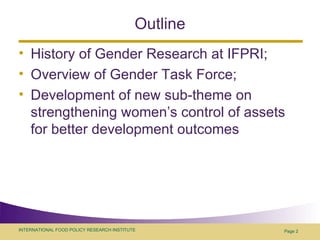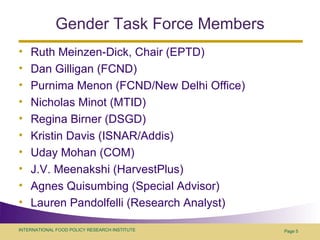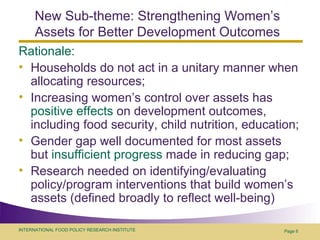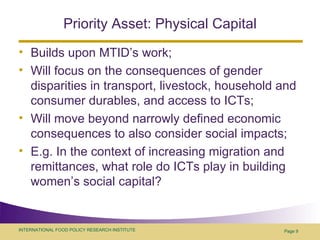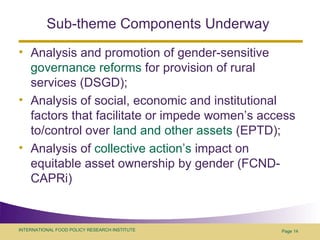Strengthening Women’s Assets
- 1. New Directions for Gender Research at IFPRI Ruth Meinzen-Dick EPTD Staff Meeting October 4, 2007
- 2. Outline History of Gender Research at IFPRI; Overview of Gender Task Force; Development of new sub-theme on strengthening women’s control of assets for better development outcomes
- 3. History of Gender Research at IFPRI Women's role and agricultural technology (Kumar, 1987); Nutritional effects of commercialization of a woman's crop: irrigated rice in The Gambia (von Braun et al. 1994); MP17 Gender and Intrahousehold Research Program(1993-2003) 4 main countries/8 supplemental countries; 4 datasets, 55+ peer-reviewed publications; “ has changed minds and contributed to research as an international public good” (Jackson, 2005)
- 4. Gender Task Force Objectives Established in 2004 to: Support researchers with integrating gender into their research portfolios; Represent IFPRI’s gender research externally; Identify new areas for concentrated research on gender at IFPRI
- 5. Gender Task Force Members Ruth Meinzen-Dick, Chair (EPTD) Dan Gilligan (FCND) Purnima Menon (FCND/New Delhi Office) Nicholas Minot (MTID) Regina Birner (DSGD) Kristin Davis (ISNAR/Addis) Uday Mohan (COM) J.V. Meenakshi (HarvestPlus) Agnes Quisumbing (Special Advisor) Lauren Pandolfelli (Research Analyst)
- 6. New Sub-theme: Strengthening Women’s Assets for Better Development Outcomes Rationale: Households do not act in a unitary manner when allocating resources; Increasing women’s control over assets has positive effects on development outcomes, including food security, child nutrition, education; Gender gap well documented for most assets but insufficient progress made in reducing gap; Research needed on identifying/evaluating policy/program interventions that build women’s assets (defined broadly to reflect well-being)
- 7. Key Research Questions: What are social/economic/institutional barriers that facilitate/impede women’s control of assets? What interaction/substitution of assets is needed in different contexts? What are effective strategies for reducing gender gaps in assets, both in the short and long-term? How can policy linkages be exploited across sectors? What lessons can be learned by comparing across studies?
- 8. Priority Asset: Natural Capital Builds upon EPTD’s sustainable land management work with links to CAPRi; Will evaluate national policies and local-level interventions that have attempted to strengthen women’s property rights, including land, water, trees and other natural resources E.g. Under what conditions are women able to successfully claim access to land to which they are entitled both customarily and through law? Under what conditions are they unsuccessful?
- 9. Priority Asset: Physical Capital Builds upon MTID’s work; Will focus on the consequences of gender disparities in transport, livestock, household and consumer durables, and access to ICTs; Will move beyond narrowly defined economic consequences to also consider social impacts; E.g. In the context of increasing migration and remittances, what role do ICTs play in building women’s social capital?
- 10. Priority Asset: Human Capital Builds upon FCND’s work on Large-Scale Interventions to Enhance Human Capital; What are the long-term impacts of interventions designed to improve women’s health and nutrition
- 11. Priority Asset: Social Capital Builds upon FCND’s findings that men and women accumulate different types of social capital; Will evaluate the role of women’s social networks in accumulating assets through productive activities and in mitigating shocks; E.g. How effective have different group-based programs targeting women (e.g. microfinance) been at strengthening women’s social capital?
- 12. Priority Asset: Political Capital Builds upon IFPRI’s governance work to examine the consequences of the political gender gap on other types of asset accumulation; E.g. How do government policies and laws affect women's possibilities to own assets, especially land? E.g. What impact does women’s political participation at different levels of government have on resource allocation?
- 13. Priority Asset: Information Builds upon ISNAR’s innovations work; Will focus on extension services and women’s participation under both conventional and new forms of agricultural advisory services; E.g. What role do women play in setting priorities and developing, disseminating and evaluating agricultural innovations? E.g. What kinds of extension systems (e.g. group-based, male or female extension agents) are most effective in reaching women, particularly where there are strong gender differences in responsibilities for agriculture?
- 14. Sub-theme Components Underway Analysis and promotion of gender-sensitive governance reforms for provision of rural services (DSGD); Analysis of social, economic and institutional factors that facilitate or impede women’s access to/control over land and other assets (EPTD); Analysis of collective action’s impact on equitable asset ownership by gender (FCND-CAPRi)
- 15. Implementation/Methodology Sub-theme to be led jointly by EPTD and FCND with institute-wide input and collaboration; Multi-disciplinary in scope, using both quantitative and qualitative research methods; Use of IFPRI panel data to investigate the extent and consequences of gender differences in different types of assets; New data collection to build on methods being developed for EPTD/Yale University study;
- 16. Consultative meeting November 13 th and 14 th 2007 to set sub-theme research priorities and build partnerships; Larger workshop slated for spring 2008 with potential World Bank and MCC funding and publication output Implementation/Methodology (cont’d.)
- 17. Final Note For more information on IFPRI’s gender research: http://www.ifpri.org/themes/gender/gender.htm Sign up for IFPRI’s Gender Interest Group, soon to be…a new Gender Blog!
Editor's Notes
- When FCND’s MP17 program ended in 2003, SMT decided to establish a Gender Task Force because the other divisions had not systematically incorporated gender into their research programs.
- Support includes: Helping researchers Identify gender dimensions of work; Providing literature and guidance on methods; Reviewing proposals; Identifying funding opportunities; Organizing brown bags; As well as more concentrated support such as developing the gender strategy for the new APSF program in Nigeria
- The Gender Task Force is an institute-wide mechanism but is housed in EPTD
- Examples of positive effects: the greater a woman’s asset holdings at marriage, the larger the share the household spends on children’s education (Quisumbing and Maluccio 2000). In Bangladesh, a higher share of women’s assets is associated with better health outcomes for girls (Hallman 2000). In a cross-site analysis in Sri Lanka, West Bengal and Kerala, Bhatla et al. (2006) find that women’s property ownership serves as a protective factor against domestic violence. The research program will not limit itself to a narrow definition of assets (i.e. natural and physical capital) but also includes human, social and political capital, and access to information, in order to allow greater scope for policy interventions and to exploit policy linkages across sectors.
- Regina’s project: Much remains to be learned about what works best, where, and why. Will undertaking surveys and qualitative case studies to compare governance reforms in Ghana, Ethiopia, India, and Sri Lanka Will also create indicators to measure the performance of rural service provision in a gender-specific way and will work on developing capacity for inclusive local government. Agnes’s project: Will investigate the long-term impact of one particular intervention—agricultural technology disseminated through women's groups. Ultimate aim of the project is to make collective action more effective and enhance its impact on more equitable asset ownership by gender, and reduced vulnerability.


